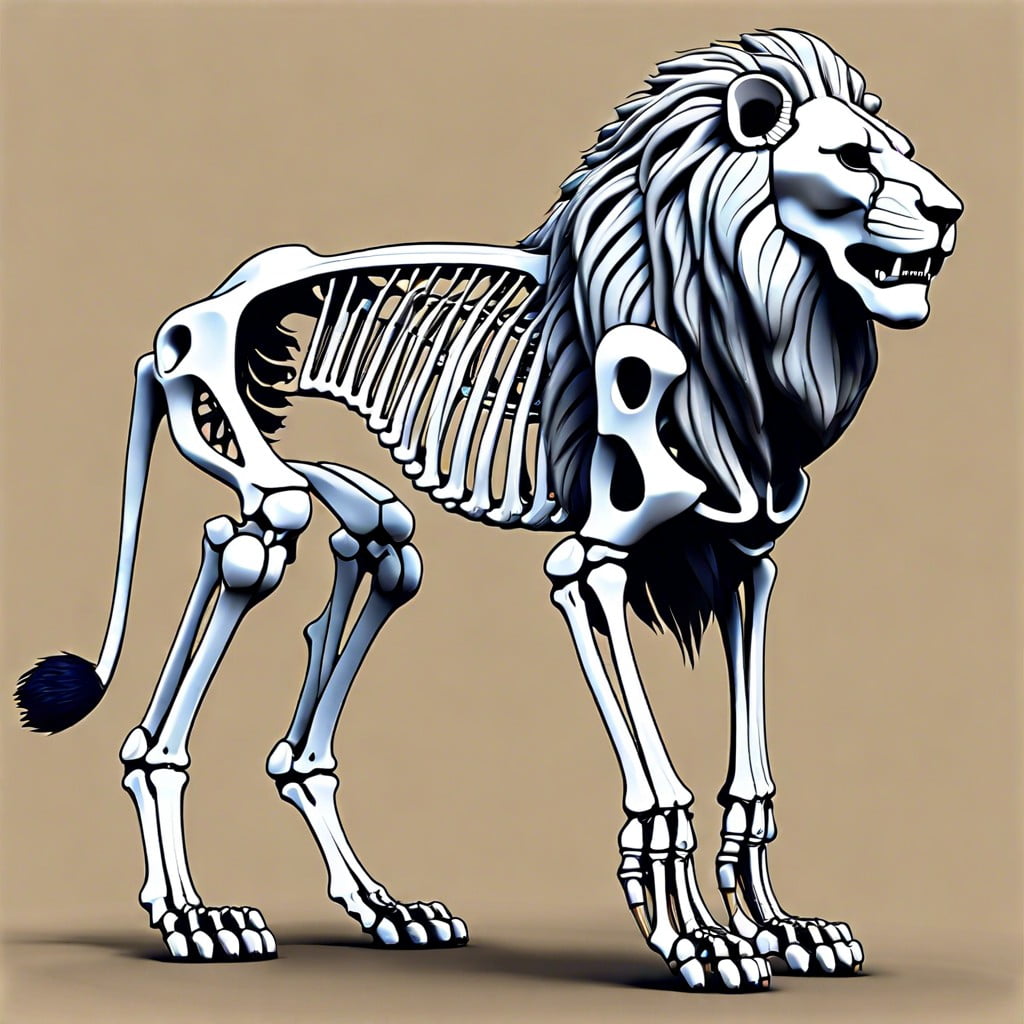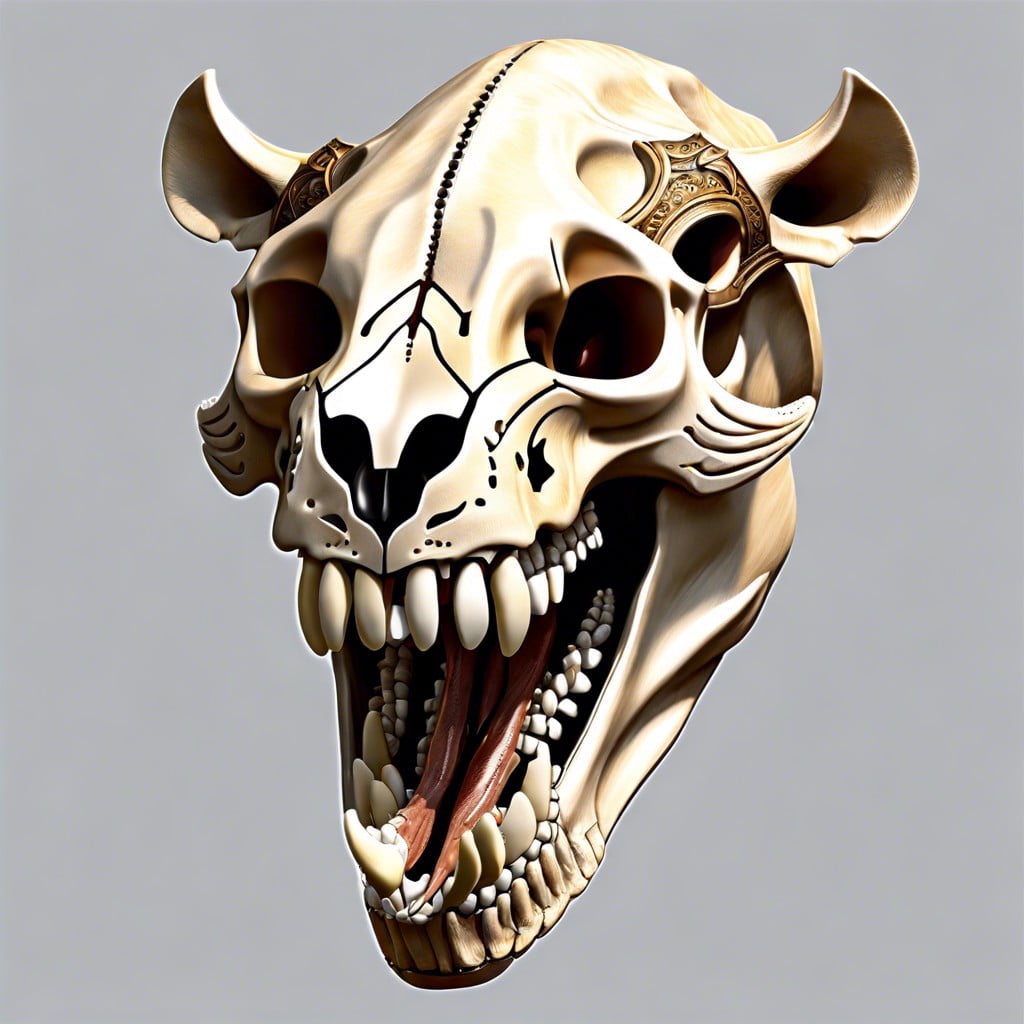Last updated on
Diving deep into the composition of a lion’s skeleton is bound to intrigue because it uncovers the secrets of this majestic beast’s strength, agility, and adaptability in the wild.
Key takeaways:
- Lion skeleton composed of 250 bones for strength and agility.
- Skull and dentition optimized for powerful bites and prey subjugation.
- Flexible spine allows sharp turns, leaps, and energy distribution.
- Powerful limbs, toe-walking, and shoulder/hip flexibility for agile locomotion.
- Unique skeletal adaptations aid in hunting and prey capture.
Basic Structure of the Lion Skeleton

The lion skeleton, composed of approximately 250 bones, serves as the framework supporting the largest predatory cat in Africa. Notably, the bones are robust and muscular, providing the necessary strength for hunting and territorial defense.
Pointed out below are several aspects illustrating the basic structure:
- The skull, large and powerful, houses an extensive brain and anchors strong jaw muscles, facilitating a biting force that is critical for prey subjugation.
- Long, slender limb bones attribute to the lion’s agile movements, while the shoulder blades are unattached to the collarbone, allowing for a greater range of motion, essential during sprints.
- The spine is remarkably flexible, with loose jointed lumbar vertebrae, which aids in absorbing the impact of leaps and lunges.
- In contrast to many other mammals, the tail vertebrae include a distinct tufted end, which assists in balance and communication.
- Lastly, the paddle-shaped ribs protect internal organs while providing a respiratory bellows effect crucial for thermoregulation during the exertion of hunts.
These skeletal characteristics provide insight into the physical makeup crucial for a lion’s survival in the wild.
Skull and Dentition

The robust skull of a lion is characterized by a broad forehead, strong jaw muscles, and a square, shortened muzzle allowing for powerful bites. Equipped with 30 teeth, the permanent set includes conical canines to grip and kill prey, incisors to nip and nibble, and carnassial molars specialized for shearing flesh. Incapable of chewing, these large molars work like scissors, a feature shared with other carnivores.
The dental formula is I3/3, C1/1, P4/3, M1/1, reflecting adaptation to a predatory lifestyle. These dental attributes, combined with a muscular and heavy head, are key to the lion’s role as a top predator, granting it the capability to take down and consume large prey efficiently.
Vertebral Column and Spine Flexibility
The vertebral column of a lion is exceptionally flexible, a feature that grants it a significant advantage in its natural habitat. Composed of individual vertebrae, linked by ligaments and cushioned by intervertebral discs, this flexibility facilitates the lion’s ability to make sharp turns and sudden leaps necessary for catching prey.
Key points about the lion’s spinal flexibility include:
- Segmentation and Adaptability: The lion’s spine includes various segments: cervical, thoracic, lumbar, sacral, and caudal. Each segment has a specific number of vertebrae, tailored to support the lion’s predatory lifestyle.
- Enhanced Locomotion: The flexibility of the lion’s spine contributes to its agility and speed. During a chase, the spine extends and flexes, increasing stride length and propelling the lion forward rapidly.
- Prey Capture: When seizing prey, a lion needs to maintain balance and manage the force transferred to its body. Its spine allows for a controlled distribution of energy, vital for holding onto struggling prey.
- Strength and Stability: The lumbar vertebrae, in particular, are robust and reinforced, providing a strong foundation for the powerful muscles of the hindquarters, which are essential in both chasing and overpowering prey.
Through this dynamic combination of flexibility and strength, the vertebral column plays a crucial role in a lion’s predatory prowess.
Limbs and Locomotion
Lions possess powerful forelimbs and strong, muscular hindquarters. The forelimbs, equipped with large paws and retractable claws, aid in grappling prey and fighting. Their anatomy is designed for short bursts of speed and explosive power rather than endurance, with a large proportion of fast-twitch muscle fibers.
The bones are dense, supporting their strength and providing a framework for their robust muscles.
The hind legs, with a longer bone structure, contribute to the lion’s ability to leap distances up to 36 feet in a single bound. Their locomotion is digitigrade; lions walk on their toes, which enhances their stealth and agility. This toe-walking is supported by strong tendons in their legs, storing energy and allowing for rapid acceleration.
Joint flexibility is also crucial, especially in the shoulder and hip regions, where it permits a greater range of motion during running, pouncing, or climbing. The combination of these skeletal and muscular features equips the lion for its role as a top predator, capable of powerful and coordinated movements necessary for stalking and capturing prey.
Unique Skeletal Adaptations for Hunting
Lions possess several key skeletal features that enhance their predatory capabilities. Their muscular forelimbs and strong shoulders allow them to pounce on and overpower their prey. Equipped with retractable claws, these appendages provide a firm grip for holding down struggling animals.
Additionally, the bones in a lion’s forelimbs are proportionally longer than the hindlimbs, giving them a mighty thrust to launch at prey.
The structure of their jaws and teeth is specialized for hunting as well. A pronounced sagittal crest on the skull anchors powerful jaw muscles, granting lions the ability to deliver a forceful bite. Their canines are long and sharp, ideal for clamping down on prey, while carnassial teeth act like scissors to slice through flesh.
Furthermore, lions have a flexible spine, especially noted in the lumbar region, which not only facilitates stealthy, low stalking but also provides a spring-like mechanism for sudden bursts of speed. This elasticity, combined with a strong pelvic region, supports their ability to leap great distances, an asset during chases.
Lastly, the tail, often overlooked, serves as a counterbalance, aiding in swift, agile maneuvers essential during the hunt. Overall, these adaptations illustrate the lion’s evolutionary optimization for its role at the top of the food chain.
Fossil Evidence of Ancient Lions
Fossil records provide a fascinating glimpse into the prehistoric world of lions, revealing that their ancestors roamed many regions of the world that current lions do not inhabit. Paleoarcheologists have discovered fossils dating back to the Pleistocene epoch, approximately 1.2 million years ago, showcasing species such as the American Lion (Panthera leo atrox), which were once native to North America.
The European Cave Lion (Panthera spelaea) is another extinct species unearthed in Eurasian regions, known for its impressive size, potentially exceeding that of modern lions. These ancients were often larger and more robust than today’s lions, an adaptation possibly tied to preying on large Pleistocene megafauna.
Analyzing fossilized remains, researchers can determine key aspects of their lifestyle, including dietary preferences and social behavior. The study of skull and dental structures, in particular, has revealed these lions’ reliance on powerful jaws and teeth to apprehend and consume large prey. Furthermore, fossils provide valuable insights into the evolutionary history of modern lions, indicating how they may have adapted to climate changes, habitat shifts, and the extinction of prey species over thousands of years.
Development From Cub to Adult
As cubs, lions have a special set of ‘milk teeth’ which include deciduous premolars, molars, and canines. These milk teeth are gradually replaced by the permanent set as they grow. Around the age of three months, cubs begin to exhibit the eruption of their permanent teeth, a process that is typically complete by the age of 13 to 15 months, coinciding with the time they start participating in hunts.
The skeletal structure of cubs is relatively flexible to absorb impacts during play and learning, crucial for developing hunting skills. Over time, the bones strengthen and solidify, preparing them for the challenges of adulthood. The growth plates, found at the ends of long bones, are responsible for lengthening during youth; they will eventually close once a lion reaches full maturity around 3 to 4 years of age.
Throughout juvenile stages, the shape of the skeleton changes. Sexual dimorphism becomes noticeable; future males develop thicker and longer limb bones and robust skulls, which support the growth of their iconic manes. Sutures in the skull, which are somewhat flexible in cubs, will fully fuse in adults, signifying the end of cranial growth.
The gradual increase in body size is aligned with skill acquisition, lending to the eventual adult prowess lions are renowned for. The complete transition to an adult skeleton equips lions with the necessary physical attributes to partake fully in territorial defense and hunting as key members of their pride.
Skeletal Differences Between Male and Female Lions
Male lions typically possess a robust and slightly larger skeletal structure compared to females, which supports their greater muscle mass and overall size. This size difference is particularly notable in the skull, where males feature a more pronounced sagittal crest – a bony ridge on the top of the skull to which powerful jaw muscles attach.
Females, although generally smaller, have a skeletal build that is optimized for agility and endurance, which is critical for hunting and stalking prey. Their pelvic bones are also adapted for the demands of reproduction, including a wider birth canal to facilitate the birthing process.
Furthermore, the vertebrae in the mane-bearing region of male lions are modified with extended projections, which provide additional support for the weight of their thick mane. This mane is not only a distinctive feature but also plays a role in protecting the neck during territorial fights.
While both sexes exhibit a high degree of skeletal similarity, these subtle but significant differences are a direct result of their specialized roles within the pride structure and are crucial for their respective survival strategies in the wild.
Impact of Inbreeding On Bone Structure
Inbreeding among lion populations can lead to a variety of skeletal issues due to the reduced genetic diversity it brings about. As lions are forced into smaller, isolated groups because of habitat loss, the genetic pool diminishes, increasing the likelihood of genetic disorders:
1. Genetic Disorders: Reduced genetic variation can result in the manifestation of recessive genetic conditions, which may cause abnormal bone development and structure.
2. Bone Density and Strength: Inbreeding can negatively affect bone density and strength, making lions more susceptible to fractures and injuries that can impair their ability to hunt and survive.
3. Facial Asymmetry: A common consequence of inbreeding is facial asymmetry where the skull bones may develop unevenly, potentially affecting the lion’s bite and ability to feed.
4. Reproductive Health: Skeletal malformations as a result of inbreeding also impact reproductive success—deformities in the pelvic area can lead to complications during childbirth.
These points underscore the importance of genetic diversity for the structural health and overall well-being of lion populations. Conservation efforts often include genetic management to mitigate the adverse effects of inbreeding on bone structure and to ensure the vigor of future generations.
Conservation Efforts for Lion Populations
Efforts to conserve lion populations are multifaceted, addressing both habitat concerns and the direct causes of population decline. Anti-poaching laws and enforcement reduce illegal hunting, ensuring lions can mature and maintain their natural role in the ecosystem. Habitat preservation is crucial, encompassing the protection of large swathes of savannas and forests essential for the species’ survival, alongside the establishment of wildlife corridors that promote genetic diversity by connecting lion populations.
Community involvement in conservation programs empowers local stewardship and provides economic incentives through eco-tourism. Education plays a key role, with initiatives aimed at mitigating human-lion conflict and promoting coexistence. Scientific research, including genetic studies, informs effective breeding programs and health management, contributing to the regeneration of robust lion populations. International collaborations, such as CITES, regulate trade in lion parts to discourage exploitation. Collectively, these actions contribute to a sustainable future for lions in the wild.




